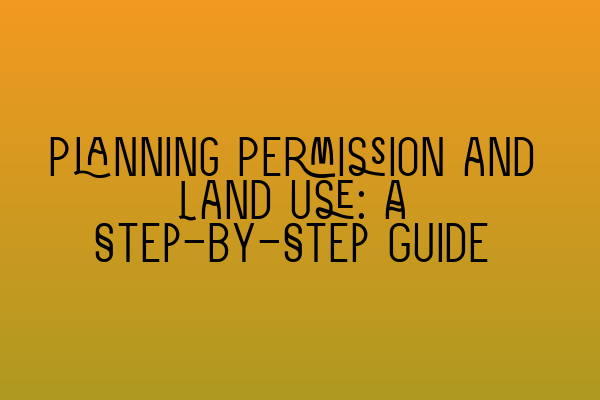Planning Permission and Land Use: A Step-by-Step Guide
As a property owner or developer, navigating the complexities of planning permission and land use can be a daunting task. Understanding the process and requirements is vital to ensuring the smooth progression of your project. In this guide, we will take you through a step-by-step approach to obtaining planning permission and utilizing your land effectively.
1. Understanding the Basics
Before delving into the intricacies of planning permission, it is important to grasp the basics. Planning permission is the legal consent granted by the local planning authority (LPA) that allows you to carry out specific work on your property or land. This includes construction, alterations, change of use, and other development projects. Without planning permission, you risk being subject to enforcement action and potential financial penalties.
2. Assessing the Feasibility
Once you have a project idea in mind, it is crucial to assess its feasibility before diving headfirst into the planning process. Consider factors such as the local zoning regulations, environmental impact, and community implications. Understanding these factors early on will save you time, money, and potential disappointment later in the process.
3. Engaging with the Local Planning Authority (LPA)
Before submitting a formal planning application, it is advisable to engage with the LPA to gauge their views on your proposed project. This pre-application advice can provide valuable insight into any potential concerns or requirements. It also allows you to make adjustments to your plans to increase the chances of a successful application.
4. Preparing a Planning Application
Once you have gathered the necessary information and adjusted your plans based on the LPA’s feedback, it’s time to prepare a comprehensive planning application. This includes completing the relevant forms, providing detailed plans and drawings, and addressing any specific requirements set by the LPA. It is crucial to ensure that your application is complete and accurate to avoid delays or rejection.
5. Submitting the Planning Application
Once your application is ready, it’s time to submit it to the LPA. This can usually be done online or through traditional mail. Make sure to include all required documents, pay the application fee, and adhere to any specific submission guidelines. It is essential to keep track of the application’s progress and respond promptly to any requests from the LPA during the review process.
6. Assessing the Impact
As part of the planning process, the LPA will assess the impact of your proposed development on various aspects, including the environment, traffic, infrastructure, and neighboring properties. This assessment may involve consulting with relevant authorities and stakeholders. It is important to provide accurate and comprehensive information to support your case and address any concerns raised by the LPA.
7. Decision-Making
Following the assessment, the LPA will make a decision on your planning application. This decision can take several forms: approval, approval with conditions, refusal, or deferral. If your application is approved, congratulations! You can proceed with your project, adhering to any conditions set by the LPA. If your application is rejected, you have the right to appeal the decision through the appropriate channels.
8. Implementing the Decision
Once you have obtained planning permission, it is important to ensure that you comply with the conditions set by the LPA. Failure to do so can result in enforcement action and potential penalties. Additionally, it is important to keep the LPA informed of any changes to your plans during the implementation phase.
9. Utilizing Your Land Effectively
Once you have obtained planning permission, you have the opportunity to utilize your land effectively. This may involve construction, change of use, or other development projects. It is crucial to adhere to the permissions granted and comply with any ongoing obligations set by the LPA. Taking the time to plan and execute your project effectively will ensure the best outcomes for your land use.
In conclusion, obtaining planning permission and effectively utilizing your land requires careful consideration, thorough planning, and adherence to the regulatory framework. By following this step-by-step guide, you can navigate the process with confidence and increase the chances of a successful outcome for your property or development project.
Related Articles:
– SQE 1 Practice Exam Questions
– SQE 1 Practice Mocks FLK1 FLK2
– SQE 2 Preparation Courses
– SQE 1 Preparation Courses
– SRA SQE Exam Dates
